My first pair of cycling shoes were a pair of inexpensive mountain bike shoes. Unfortunately, I was on a tight budget, so I found a pair of discontinued Pearl Izumi shoes that fit like a sneaker with cleats.
And they were OK to get started, but as I progressed in my cycling journey, I knew I needed a road-specific shoe – but the fit of a road shoe is entirely different than the shoes I started with.
In this article, we’ll talk about how cycling shoes should fit. We’ll talk about stiff road shoes, how they should feel, and how to know if yours fit correctly.
We’ll also talk a little bit about mountain bike shoes and how they’re different. We’ll even talk about how to measure your feet so you can find the right size shoe for you. Let’s get started.
Key Takeaways: How Should Cycling Shoes Fit?
- Road cycling shoes aren’t meant for walking so they won’t fit like a pair of trainers
- Cycling shoes should fit securely in the heel and have just a bit of room in the toes
- Road shoes will be very stiff, while mountain bike shoes will have more flex
- Cycling shoes should keep your heel from slipping in and out of the shoe
- If your shoes pinch, slip or give you hot spots, you might have the wrong type or size of shoe
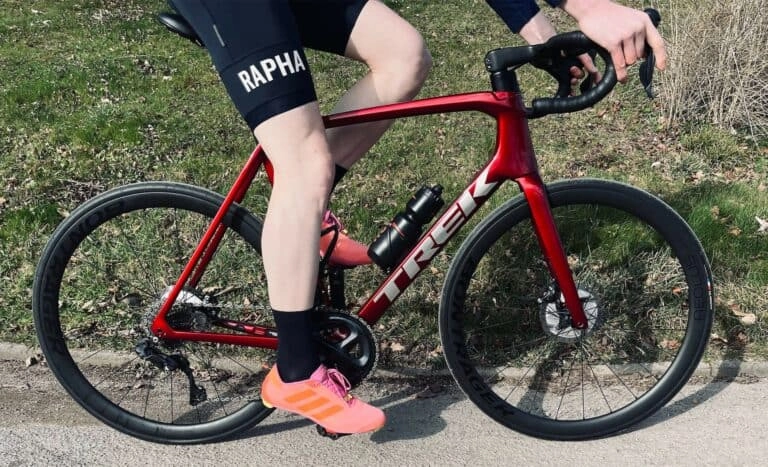
1. How Should A Cycling Shoe Fit?
My high school band director commuted to work by bike every day. I hate to admit that I giggled every time he half-tiptoed- half-slipped his way into the band room before he changed from his cycling shoes to his work shoes.
What I didn’t know back then was that cycling shoes aren’t designed for walking – they’re actually made for good pedaling technique and a solid transfer of power from your leg to your pedal.
So it’s no surprise that his stiff cycling shoes were hard to walk in, especially on the slippery cement floor of the band room.
Road Shoes
A road cycling shoe should be stiff – it won’t have a flexible sole like your running shoes. You won’t be able to bend or flex the shoe. This will help you transfer as much power as possible from your legs and into your feet and pedals to make your pedaling as efficient as possible.
If your shoe flexes and bends, you’ll lose power where you need it most.
Mountain Bike Shoes
The exception here is a mountain bike shoe. You may prefer a flexible sole when mountain biking because you might need to do a lot of hike-a-bike over obstacles or parts of the trail that are impassable.
A flexible sole will help you have more grip and better balance, while a stiff sole could be slippery.
Gravel Shoes
Gravel shoes also have stiff soles because you aren’t hopping on and off the bike a lot, especially in a gravel race. A lot of gravel riding is on gravel roads, so you should be able to ride most of the time.
For this reason, you don’t need flexible shoes unless you prefer them. Off-road shoes will have rubber tread on the bottom to help you walk in spite of the stiff soles.
Cyclocross Shoes
For cyclocross, I prefer my flexible mountain bike shoes because I have to run a lot and it’s easier for me. At the competitive level, though, cyclocross shoes are stiffer because the more experienced riders get off the bike less – they have more skills to stay on the bike for tough obstacles.
Also, because they tend to only run on very steep hills or really gnarly obstacles, they use the stiff shoes with toe spikes.
2. Getting the Best Fit for Your Cycling Shoes
No matter what discipline of cycling you ride, your cycling shoe needs to fit snugly at the heel so your heel doesn’t slip in and out while you pedal, but it shouldn’t be so tight that it hurts. This will prevent blisters and keep your transfer of power where it needs to be.
And while you don’t want your toes or the balls of your feet to feel pinched by a too-narrow shoe, you also don’t need room for your foot to move around inside the shoe.
Your toes shouldn’t hit the front of the shoe – but you only need a maximum of 1.5 cm of toe room since your foot doesn’t roll in the shoe like a running shoe.
Your arch should be well-supported. Some cycling shoes come with a variety of arch supports, so you can change out the support depending if you have high or low arches. Some cycling shoes just come with a basic insole. If yours doesn’t give your foot enough support, you can easily change out the insole for another kind.
Arch support seems key to me – think about it. When you walk in a normal pair of shoes, those shoes flex and bend with your walking motion. But on a bike when you are transferring power, the stiff sole of a cycling shoe means no flex, so what will try and flex is your foot.
And having decent arch support means keeping your foot in the correct position. Overall, your feet need to be in a neutral but well-supported position throughout your ride.
Cycling shoes have strategically placed holes in the bottom of the shoe for your cleats. The cleats will lock into your clipless pedals. If your shoes are the wrong size, the ball of your foot will not line up correctly with the pedals, which will lead to poor pedalling efficiency or injury.
And remember, the type of shoes and number of cleat holes will also dictate the type of pedals you can use. Typically three-hole cleats for road, or two-hold cleats for off-road.

Not every brand of shoe will fit the same. Some may have a wider toe box. Others may have a tighter heel. Keep in mind that cycling shoes are not designed to stretch out or loosen over time. You want them to fit correctly from the first time you put them on.
3. How Tight Should Cycling Shoes Be?
Cycling shoes should fit snugly and keep your foot secure in the shoe. They should not be so tight that they pinch or cause pain. If your toes touch the end of the shoe when you are standing up, they may be too tight or too small.
If they put pressure across the balls of your feet, they are too tight, although you may need a wider shoe but not a bigger shoe. Keep in mind that your feet may swell a bit as the day goes on.
If your shoes are too loose, you may be able to correct the fit with a thick insole, although this isn’t always the case. Try this – with shoes on, stand on tip-toe and try to get your heels to move. Ideally, your heels should stay in place and not slip out easily.
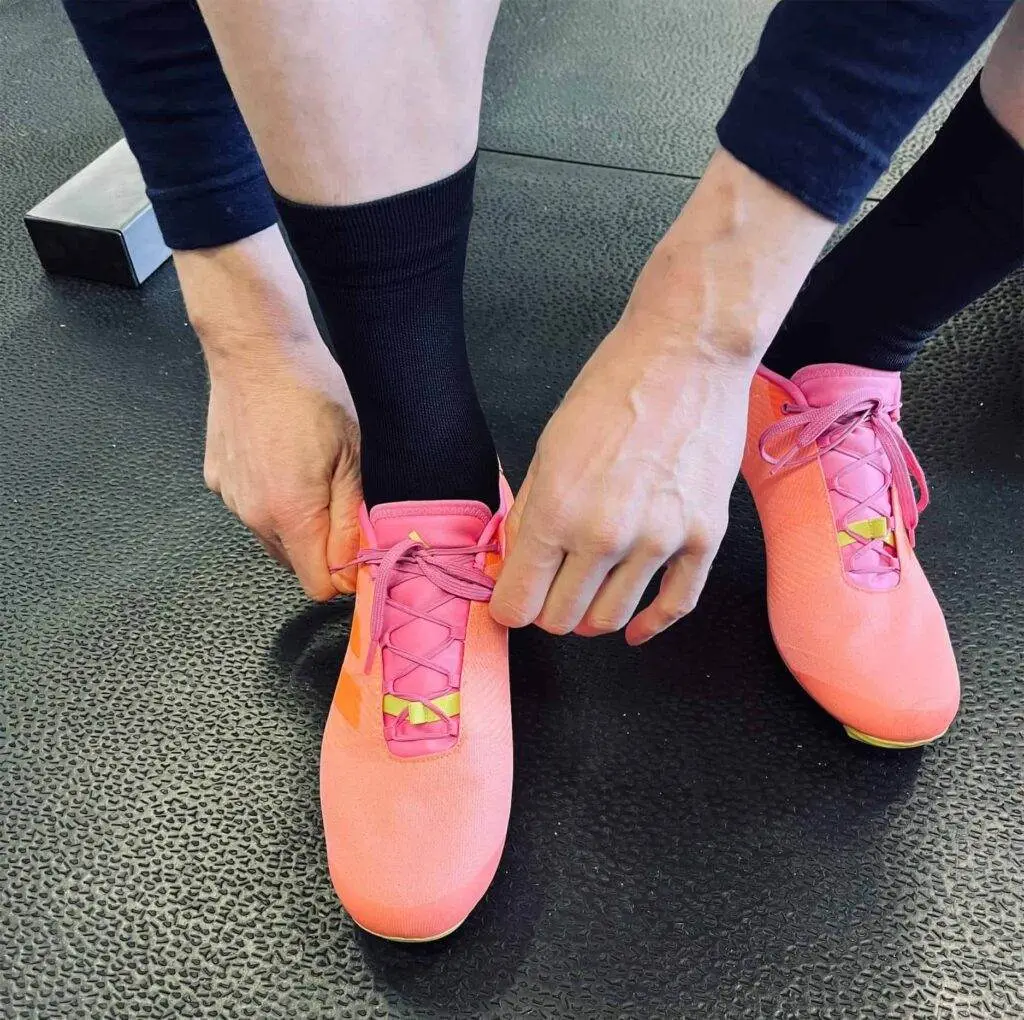
4. How to Measure Your Foot for Cycling Shoes
The best way to purchase new cycling shoes is to go to a bike shop that sells a variety of brands so you can try different ones on. However, since cycling shoes are such a niche market, you may find yourself needing to purchase them online. Whether you are ordering online or purchasing in a physical store, you’ll want to measure your feet, so you have a good idea of what size you need.
Here’s how to measure your feet – it might be a lot easier if you have a friend to help you.
Put a piece of paper on the floor against the wall and stand on it with your bare feet, putting your heels against the wall.
Have your friend trace your feet as precisely as possible.
Step off the paper and measure your foot at its longest point in CM or MM. You may also want to measure the width. Then you can compare your foot measurements to the size chart of the brand of cycling shoe you wish to purchase.
Regardless of where you purchase your shoes, you’ll want to make sure they have a good return policy. Cycling shoes are an investment and you want to make sure you can exchange or return them if they don’t fit well.
A good example here – one of the Pedallers’ team go-to road shoes are Bontrager, not only because of the fit but also the ‘30-day unconditional guarantee’ – buy them, try them, and if you don’t like them just take them back within 30 days for a full refund. It’s a 30-day test ride!
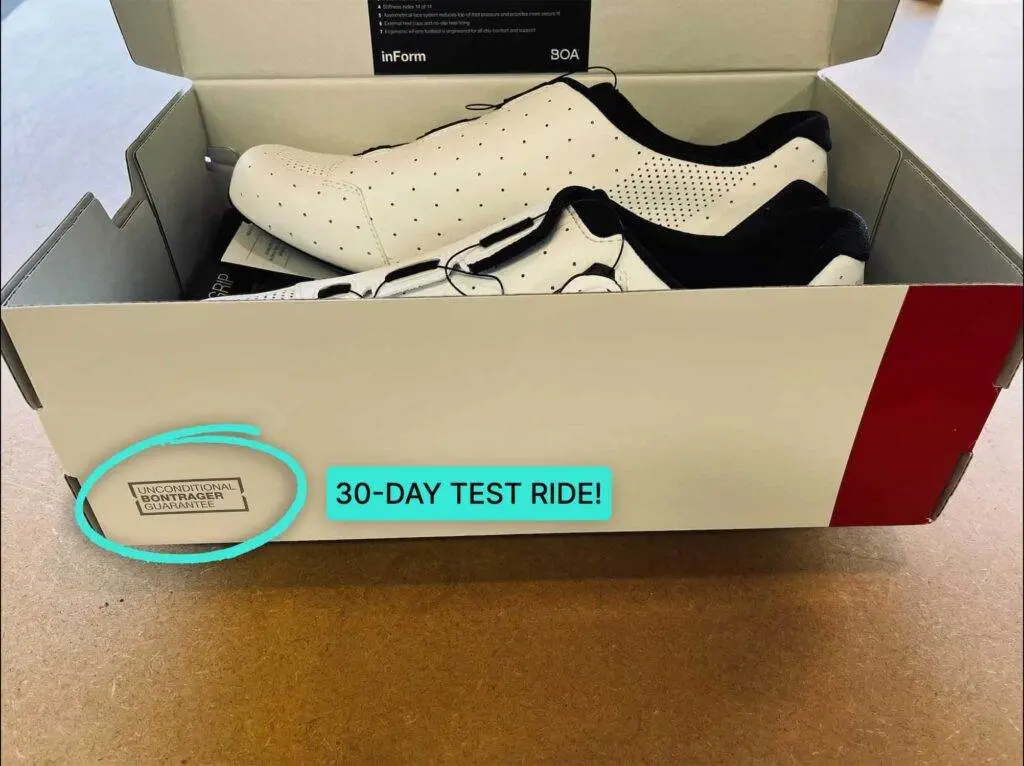
5. Special Cycling Shoe Considerations
If you have problems with your feet, legs, or pedalling, you might need to get a professional fit. You may need special insoles or even wedges for your shoe. You might want to consider special inserts for the inside of your shoe or even cleat wedges, as well. A good bike fitter will help you get the right fit.
6. How Much Toe Room In Cycling Shoes?
If you look at a pair of running shoes or trainers, you’ll have extra room in the toe box because your foot flexes and rolls as you run and walk. Cycling shoes, however, aren’t made to do this. Instead, they’re made to be a solid support for your foot to keep your foot in a neutral position. So you don’t need extra room in the toe box. In addition, you don’t want your toes to brush up against the front of the shoe, so you really only need 1.5 CM or so of space for your toes.
7. How Should Road Bike Shoes Fit?
As we mentioned before, road bike and mountain bike shoes are a little bit different. First, road bike shoes should be stiff because they aren’t made for doing much walking. The heel should be snug enough to hold your fit so that it doesn’t slide around.
Finally, they should fit snugly, with just enough room in the toe box that your toes don’t rub up against the front of the shoe when you pedal. Many road bike shoes have a dial to tighten them.
You’ll want to crank the dial to tighten the shoe until it fits snugly without pinching. Alternatively, you may have hook and loop straps on your shoes or even laces. Again, tighten them until the shoe fits snugly, making sure to tuck in the laces, so they don’t get caught in your chain or gears.
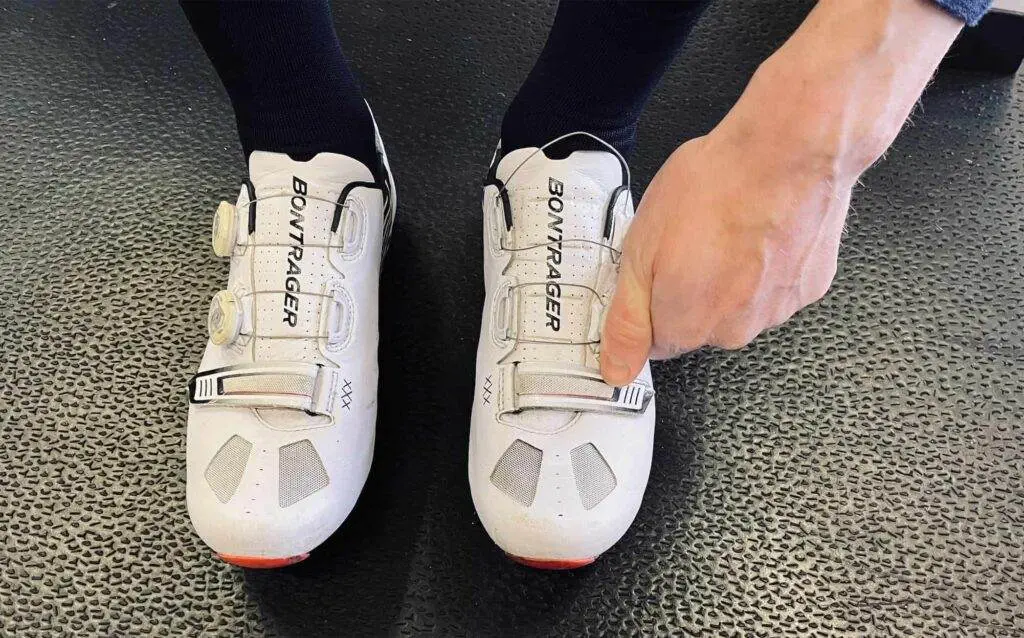
8.How Should Mountain Bike Shoes Fit?
Mountain bike shoes are a bit different. If you choose a flexible mountain bike shoe, it should fit more like a sneaker or a pair of trainers. This enables you to walk, climb, and easily put your foot down when you need to.
You still need to make sure your shoe fits correctly because a shoe that is too big will mean your cleats will be in the wrong spot in relation to your shoe. If your shoes are too small, they’ll pinch.
Make sure your shoes are just tight enough to fit snugly without pinching. Tuck any laces into the shoe or lace straps, so they don’t get tangled in your bike or terrain.
Best Cycling Shoes Fit Tips (Closing Thoughts)
Every brand’s cycling shoe will fit a little bit differently than other brands. For example, a size 38 in one brand might fit differently than a size 38 in another brand. So you may need to try a few pairs to find one that really fits your foot. If you have extra wide feet, don’t just size up because then you’ll have too much room in the heel. Instead, look for a brand that offers wider sizing.
Overall, you need a cycling shoe that fits snugly, supports your foot, and doesn’t hurt.
Getting a high-quality pair of bicycle shoes is an investment that can make a big difference on your riding experience. Put on your new cycling shoes with confidence and style and hit the road (or the trails)!
What brand of shoes works for you? Do you find that MTB shoes actually work better for you on the road? Drop a message in the comments section below and let us know how you get on with your cycling shoes!
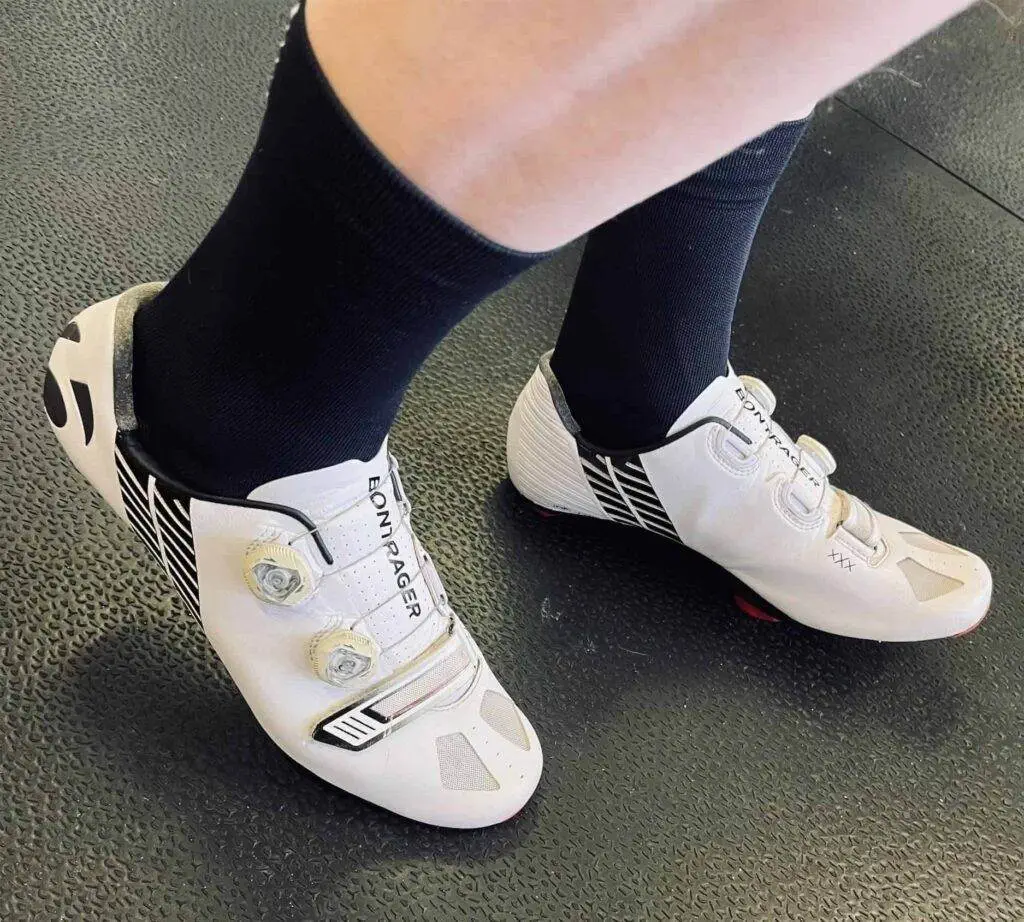
FAQ
How do you know if cycling shoes are too big?
You’ll know your cycling shoes are too big if your foot slides around inside the shoe. Your heel may slip in and out of the shoe, which can cause blisters and loss of power transfer. On the other hand, if your shoe is too long, your cleats will be too far forward.
You’ll end up pushing down on the pedals with your toes rather than the ball of your foot, which is inefficient at best and will cause foot pain and fatigue over time.
How do I know if my cycling shoes are too small?
Cycling shoes that are too small will uncomfortably pinch your toes, the balls of your feet, and even your heel. In addition, the cleat may be too far back, making it harder to pedal. As a result, your feet may get cramps, hot spots, and even blisters.
Your toes should not touch the front of your shoes when standing. If they do, they may be too small.
Should you be able to move your toes in cycling shoes?
Yes, you should be able to wiggle your toes slightly in your cycling shoes. You want them to be well-supported but not squished.
Is it better for cycling shoes to be tight or loose?
Cycling shoes should be a little bit tight rather than loose, as long as they aren’t so tight that they cause pain and discomfort. A loose shoe will allow your foot to slip around, and if it’s too loose, your foot might even slide out.
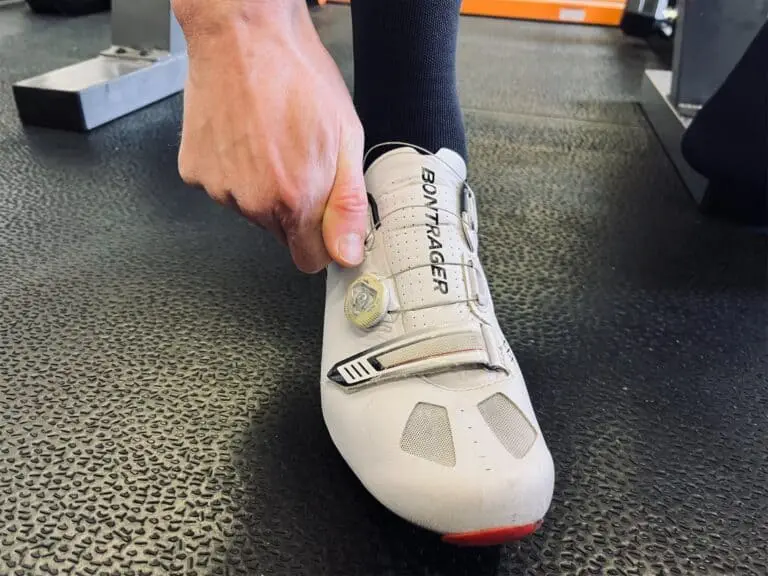
Should you go half a size up in cycling shoes?
Don’t automatically choose a shoe a half size up. Instead, get your foot measured and try on shoes until you find one that fits correctly.
